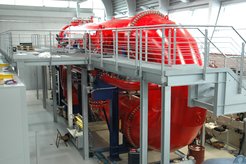
Variable Density Turbulence Tunnel
Present configuration and existing infrastructure:
The Variable Density Turbulence Tunnel (VDTT), seen on the right, is a wind tunnel that circulates pressurized gases. Working fluids are air, sulfur hexafluoride (SF6), or other noncorrosive gases. Reynolds numbers of up to Rλ~1700 can be reached with SF6 at 15bar. The tunnel is upright and consists of two measurement sections each with a cross-sectional area of 1.7m2 and lengths of 9m and 7m. The cross sections are approximately octagonal, as can be seen in the picture below. The mean flow speed can be set to between 0.5 and 5m/s. The tunnel is pressure and temperature controlled, and has optical and electrical interfaces. The pressure can be adjusted to between 1mbar and 15bar. The circulating gas can be filtered to <1μm.

